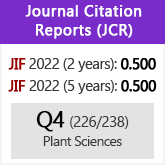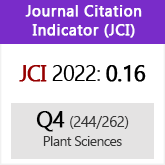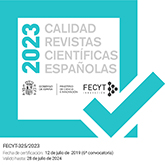Vegetative anatomy of Lophophytum mirabile subsp. bolivianum (Balanophoraceae) and the effect of its parasitism in the anatomy of the roots of its host Anadenanthera colubrina var. cebil
DOI:
https://doi.org/10.3989/ajbm.2423Keywords:
Anatomy, guts, log, root, parasitismAbstract
The objectives of this work were to study the structure of the vegetative body of Lophophytum mirabile subsp. bolivianum (Wedd.) B. Hansen, to analyze the change on roots of Anadenanthera colubrina var. cebil (Griseb.) Altschul when they are infected by this parasitic plant, and to identify the anatomical changes produced by that parasitism. L. mirabile subsp. bolivianum plants are formed by a spheroidal-narrower underground vegetative body or tuber, that externally has a dark warty surface;epidermis, stomata or trichomes are lacking. The central matrix of tuber consists of reserving parenchyma and vascular bundles. Parasitic cells located at the level of root cambium initiate the tuber formation. On the infected root of A. colubrina var.cebil, the identity of radial and axial growth of the secondary system are lost. This leads to the formation of xylem loops that affect the xylem transport and root development, which stops length growth and develops a woody gall. Infection of L. mirabile subsp. bolivianum causes profound anatomical changes in timber developing of A. colubrina var. cebil, which favor the parasite success.
Downloads
References
Aloni, R. 1995. The induction of vascular tissues by auxin and cytokinin. In: Davies, P.J. (ed.), Plant hormones: physiology, biochemistry and molecular biology: 531-546. Holanda. https://doi.org/10.1007/978-94-011-0473-9_25
Aloni, R. 2013. The role of hormones in controlling vascular differentiation. In: Fromm, J. (ed.), Plant cell monographs: cellular aspects of wood formation: 99-140. Berlín. https://doi.org/10.1007/978-3-642-36491-4_4
Bellot, S. & Renner, S. 2014. The systematics of the worldwide endoparasite family Apodanthaceae (Cucurbitales), with a key, a map, and color photos of most species. PhytoKeys 36: 41-57. https://doi.org/10.3897/phytokeys.36.7385 PMid:24843293 PMCid:PMC4023342
Carlquist, S. 2001. Comparative wood anatomy: Systematic, ecological and evolutionary aspects of Dicotyledon wood, 2nd ed. Springer-Verlag. https://doi.org/10.1007/978-3-662-04578-7
Cocucci, A.E. 1984. Hydnoraceae. In: Hunziker, A.T. (ed.), Los géneros de Fanerógamas de Argentina. Boletín de la Sociedad Argentina de Botánica 23: 164. PMCid:PMC1064379
Evert, R.E. 2006. Esau's plant anatomy, meristems, cells, and tissues of the plant body: Their structure, function, and development. Wiley Press, Nueva York.
Fagerlind, F. 1948. Bau und Entwicklung der vegetativen Organe von Balanophora. Kungliga Svenska Vetenskapsakademiens Handlingar III, 25: 1-72.
Gedalovich-Shedletzky, E. & Kuijt, J. 1990. An ultrastructural study of the tuber strands of Balanophora (Balanophoraceae). Canadian Journal of Botany 68: 1271-1279. https://doi.org/10.1139/b90-162
González, A.M. & Cristóbal, C.L. 1997. Anatomía y ontogenia de semillas de Helicteres lhotzkyana (Sterculiaceae). Bonplandia 9(3-4): 287-294.
González, A.M. & Mauseth, J.D. 2010. Morphogenesis is highly aberrant in the vegetative body of the holoparasite Lophophytum leandri (Balanophoraceae): All typical vegetative organs are absent and many tissues are highly modified. International Journal of Plant Science 171(5): 499-508 https://doi.org/10.1086/651947
González, A.M. & Solís, S.M. 2015. Anatomía y morfogénesis de las agallas producidas por Leptocybe invasa en plantas de Eucalyptus. Boletín de la Sociedad Argentina de Botánica 50(2): 141-151.
Hansen, B. 1980. Balanophoraceae. Flora Neotropica, Monograph 23: 1-80.
Heide-Jørgensen, H.S. 2008. Parasitic flowering plants. Holanda. https://doi.org/10.1163/ej.9789004167506.i-438 PMCid:PMC2605821
Heide-Jørgensen, H.S. 2013. The Parasitic Syndrome in Higher Plants. In: Joel, D.M. & al. (eds.), Parasitic Orobanchaceae. Parasitic Mechanisms and Control Strategies. Berlín, Heidelberg.
Holzapfel, S. 2001. Studies of the New Zealand Root-Parasite Dactylanthus taylorii (Balanophoraceae). Englera 22: 1-176. https://doi.org/10.2307/3776780
Hsiao, S.C., Mauseth, J.D. & Gómez, L.D. 1993. Growth and anatomy of the vegetative body of the parasitic angiosperm Helosis cayennensis (Balanophoraceae). Bulletin of the Torrey Botanical Club 120: 295-309. https://doi.org/10.2307/2996994
Hsiao, S.C., Mauseth, J.D. & Gómez, L.D. 1994 Growth and anatomy of the vegetative body of the parasite angiosperm Langsdorffia hypogaea (Balanophoraceae). Bulletin of the Torrey Botanical Club 121: 24-39. https://doi.org/10.2307/2996881
Hsiao, S.C., Mauseth, J.D. & Peng, C.I. 1995. Composite bundles, the host/ parasite interface in the holoparasitic angiosperms Langsdorffia and Balanophora (Balanophoraceae). American Journal of Botany 82: 81-91. https://doi.org/10.2307/2445790
Johansen, D.A. 1940. Plant Microtechnique. Nueva York.
Kuijt, J. 1969 The biology of parasitic flowering plants. California.
Kuijt, J. & Hansen, B. 2015. Balanophorales. In: Kubitzki, K. (ed.), Flowering Plants. Eudicots, The Families and Genera of Vascular Plants Volume XII, Santalales, Balanophorales: 192-208. Suiza.
Luque, R.H., Sousa, C. & Kraus, J.E. 1996. Métodos de coloraçao de Roeser (1972)-modificado- e Kropp (1972) visando a subtituicao do azul de astra por azul de alciaô 8 GS ou 8 GX. Acta Botánica Brasilica 10: 199-212.
Mangenot, G. 1947. Recherches sur l'organisation dune Balanophoracée: Thonningia coccinea. Revue générale de Botanique 54: 201-294.
Martínez, O.G., Barrandeguy, M.E., García, M.V., Cacharani, D.A. & Prado, D.E. 2013. Presencia de Anadenanthera colubrina var. colubrina (Fabaceae, Mimosoideae) en Argentina. Darwiniana, nueva serie 1(2): 279-288. https://doi.org/10.14522/darwiniana.2013.12.536
Mauseth, J.D., Hsiao, S.C. & Montenegro, G. 1992. Vegetative body of the parasitic angiosperm Ombrophytum subterraneum (Balanophoraceae). Bulletin of the Torrey Botanical Club 119: 407-417. https://doi.org/10.2307/2996729
Meijer, W. 1993a. Hydnoraceae. In: Kubitzki, K. & al. (eds.), The families and genera of vascular plants, volume II, Flowering Plants. Dicotyledons. Magnoliid, Hamamelid and Caryophyllid Families: 341-343. Berlín.
Meijer W. 1993b. Rafflesiaceae. In: Kubitzki, K. & al. (eds.), The families and genera of vascular plants, volume II, Flowering Plants. Dicotyledons. Magnoliid, Hamamelid and Caryophyllid Families: 557-563. Berlín.
Moore, L.B. 1940. The structure and life-history of the root parasite Dactylanthus taylori Hook f. New Zealand Journal of Science and Technology 21-22: 206B–224B.
Musselman, L.J. & Press, M.C. 1995. Introduction to parasitic plants. In: Press, M.C. & Graves, J.D. (eds.), Parasitic Plants. pp. 1-13. Londres.
Nickrent, D.L. [2015]. The parasitic plant connection, Balanophoraceae. http://www.parasiticplants.siu.edu.
Nickrent, D.L. & Musselman, L.J. 2004. Introduction to parasitic flowering plants. The Plant Health Instructor 13: 300-315. https://doi.org/10.1094/phi-i-2004-0330-01
Nickrent, D.L., Malécot, V., Vidal-Russell, R. & Der, J.P. 2010. A revised classification of Santalales. Taxon 59: 538-558.
Ruzin, S.E. 1999. Plant microtechnique and Microscopy. Oxford University Press. PMid:9952452 PMCid:PMC32133
Sachs, T. 1981a. The control of the patterned differentiation of vascular tissues. Advances in Botanical Research 9: 151-262. https://doi.org/10.1016/S0065-2296(08)60351-1
Sachs, T. 1981b. Polarity changes and tissue organization in plants. In: Schweiger, H.G. (ed.), International Cell Biology. pp. 489-496. Berlín.
Sachs, T. 2005. Pattern formation in plant tissues. Cambridge University Press.
Sachs, T. & Cohen, D. 1982. Circular vessels and the control of vascular differentiation in plants. Differentiation 21: 22-26. https://doi.org/10.1111/j.1432-0436.1982.tb01189.x
Sato, H.A. 2015 (inéd.). Anatomía reproductiva de las especies de Lophophytum Schott & Endl. (Balanophoraceae) de la Argentina y revisión taxonómica del género en América. Tesis doctoral. Universidad Nacional del Nordeste. Corrientes, Argentina.
Shivamurthy, G.R., Arekal, G.D. & Swamy, B.G.L .1981. Establishment, structure and morphology of the tuber of Balanophora. Annals of Botany 47: 735-745.
Tennakoon Kushan U., Bolin, J.F., Musselman, L.J. & Maass, E. 2007. Structural attributes of the hypogeous holoparasite Hydnora triceps Drège & Meyer (Hydnoraceae). American Journal of Botany 94(9): 1439-1449. https://doi.org/10.3732/ajb.94.9.1439 PMid:21636511
Vöchting, H. 1892. Über Transplantation am Pflanzenkörper. Verlag H. Laupp'schen Buchhandlung, Tubinga.
Vöchting, H. 1918. Untersuchungen zur experimentellen anatomie und pathologie des pflanzenkörpers. II Die Polarität der Gewächse. Verlag H. Laupp'schen Buchhandlung, Tubinga.
Xifreda, C.C. 1999. Balanophoraceae. In: Zuloaga, F. & Morrone, O. (eds.), Catálogo de las plantas vasculares de la Rep. Argentina II. Monographs in Systematic Botany from the Missouri Botanical Garden 74: 353-354.
Zuloaga, F.O., Morrone, O.N., Belgrano, M.J., Marticorena, C. & Marchesi, E. (eds.). 2008. Catálogo de las plantas vasculares del Cono Sur. Monographs in Systematic Botany from the Missouri Botanical Garden 107: 1-3348.
Published
How to Cite
Issue
Section
License
Copyright (c) 2016 Consejo Superior de Investigaciones Científicas (CSIC)

This work is licensed under a Creative Commons Attribution 4.0 International License.
© CSIC. Manuscripts published in both the printed and online versions of this Journal are the property of Consejo Superior de Investigaciones Científicas, and quoting this source is a requirement for any partial or full reproduction.All contents of this electronic edition, except where otherwise noted, are distributed under a “Creative Commons Attribution 4.0 International” (CC BY 4.0) License. You may read here the basic information and the legal text of the license. The indication of the CC BY 4.0 License must be expressly stated in this way when necessary.
Self-archiving in repositories, personal webpages or similar, of any version other than the published by the Editor, is not allowed.

















